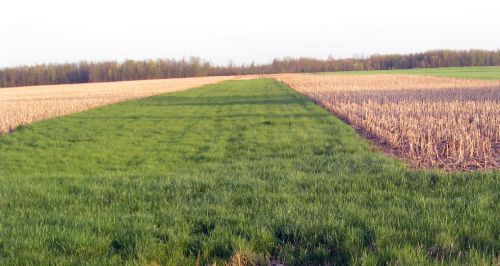Lambton farmers make a difference

Some Lambton Shores farmers are leading the way in water and soil conservation practices.
April 2012 brought heavy rains, meaning lots of muddy water moving across the fields. On Doug Rogers’ property, however, that wasn’t the case.
"With a fall of 14-18 feet (4.3-5 metres) from front to the back of our property, the water was definitely moving, but the water running off the grassed waterways was clear," explained Rogers. "The grassed waterways were doing their job."
For the last 19 years, Rogers has used grassed waterways and grass buffer strips. The grassed waterways are grassland strips in cultivated fields that slow down and filter rain runoff. Once established, maintenance involves mowing once or twice a year. Rogers also sells the hay he mows.
 Cover crops keep soil in place and improve soil quality
Cover crops keep soil in place and improve soil quality
The five to 10-metre-wide grassed buffers reduce erosion, keep topsoil on the field and provide room for wagons during harvest.
Planting cover crops also helps keep soil where it’s supposed to be.
After hearing about cover crops at the Southwest Agricultural Conference at Ridgetown, Rogers took advantage of a Healthy Lake Huron grant and planted oilseed radish and oats after wheat harvest and winter rye into soybean stubble. "The radish and oats will die off over winter, but the winter rye survives and needs to be killed off in the spring," Rogers said.
"These cover crops keep soil in place, instead of running off into the ditch, plus cover crops increase soil structure and organic matter."
Fraser Hodgson, cattle/sheep farmer and former president of the Lambton Soil and Crop Improvement Association, also used a Healthy Lake Huron grant to install eaves- troughs on his barns, diverting roof runoff from mixing with manure in the exercise yard.
Conservation practices like these and soil
testing help to reduce the amount of
phosphorus entering Lake Huron.
"Research shows that high levels of dissolved phosphorus correlate with toxic blue-green algae blooms, which can be hazardous to both humans and wildlife," said Jessica Van Zwol, Healthy Watershed Specialist with the St. Clair Region Conservation Authority.
"By soil testing and understanding the analysis, farmers can determine the right amount of fertilizer to use: enough phosphorus for a good yield, but avoiding excess that will end up in the lake."
